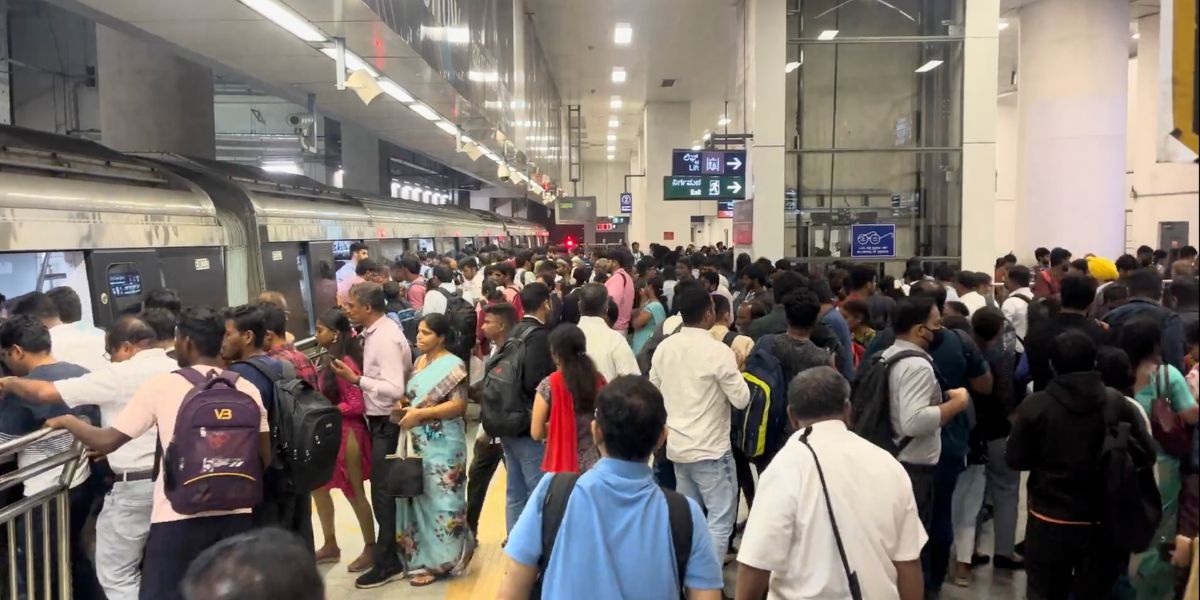The Bengaluru Suburban Rail Project, sanctioned after almost 40 years of deliberations, studies and reports, must receive the attention it deserves from public, public representatives and officials concerned.
Published Oct 21, 2025 | 2:41 PM ⚊ Updated Oct 21, 2025 | 2:41 PM

The crowd at a Bengaluru metro station during peak hour.
Synopsis: An unsustainable rate of growth of vehicles in the city has lead to over 1.2 crore vehicles in Bengaluru. At this stage adding new road infrastructure in the city will only add to the mess. The authorities should also address the slow progress of Bengaluru Suburban Rail Project and make efforts to speed up the project.
There is no possible solution for Bengaluru’s globally infamous traffic congestion unless quick, drastic and focussed improvements are made to the three pillars of Public Transport in Bengaluru — Bus, Metro and Rail — with the aim to free the roads.
An unsustainable rate of growth of vehicles in the city has lead to over 1.2 crore vehicles registered there. At this stage adding new road infrastructure in the city will only add to the mess. We already have over 12,000 km of all types of roads in an area of about 800 square kilometres. The share of commute by public transport is a pathetic 30 percent while it should be quickly raised to at least 70 percent.
We are still stuck with around 6,500 buses for the last 10 years. What we need is another 5,000 small battery buses which can also serve sub-arterial roads. Along with that a comprehensive revamp of all routes focusing on providing efficient feeder services at every Metro and Rail stations is needed.
The authorities should speed up the works of metro lines, procure train-sets before commissioning corridors and immediate steps must be taken to give final sanction to Sarjapura-Hebbal line.
On 21st October 2020, final sanction was accorded for Bengaluru Suburban Rail Project or BSRP, the third pillar of public transport in Bengaluru, with four corridors totalling 148 km at a cost of ₹15,767 Crores (about ₹110 crore/km). It was aimed to be completed by October 2026, by KRIDE, a Joint Venture between Government of Karnataka (51%) and Ministry of Railways (49%).
Corridor 1 was prioritised for completion by October 2023, since it is the most important corridor with least land acquisition and maximum expected patronage. On 20 June 2022, the Prime Minister formally laid the Foundation Stone and announced that BSRP would be completed in 40 months – by October 2025, a year earlier than stipulated in Sanction Letter.
BSRP is designed to provide nine-coach AC train services every five to 12 minutes in every corridor, with 58 modern, dedicated stations and several interchanges having excellent integration with nearby Railway, Bus and Metro stations.
With better seating, baggage space and average speed higher than Metro, the four Corridors are expected to take 20 lakh people off the roads. BSRP can be easily, quickly and economically extended to suburban towns which will help develop those towns and also help decongest Bengaluru.
Status of on-ground work, as on 21 October 2025:
In our own interests we, the citizens of Bengaluru must understand the need for BSRP and strongly demand our MPs and MLAs to study, regularly review, inspect and facilitate this much-needed and much-delayed project.
All MPs and MLAs of Bengaluru and surrounding towns must take serious and regular interest and facilitate BSRP with positivity, not blame games. Infrastructure Development Department Minister who heads this project as well as Karnataka Industrial Areas Development Board (KIADB), and the Chief Secretary who heads the KRIDE Board, must invest more time and efforts on BSRP to ensure that the work continues war-footing.
The chief minister, Bengaluru development minister, Union minister of Railways, Minister of State for Railways and Railway Board officials must regularly review and facilitate BSRP.
BSRP must be brought under Prime Minister’s Office’s PRAGATHI platform immediately – for effective monitoring and execution. This step is overdue.
Originally prioritised Corridor 1 must be taken up immediately, along with Corridor 3 since both have high patronage potential and alignments different than Metro. Without C1 and C3, the BSRP network would be incomplete and would cause commute issues for people, which would result in continuous revenue losses for the fragmented project.
Above all, Railways must actively cooperate, finalise alignments, permit extensions and allow tight integration of BSRP with their proposed Ring Rail around Bengaluru.
KRIDE must gear up for faster on-ground work and planning for future works, including commissioning of stations, manpower and training, sepots, signalling, etc.
Further, strict intermediate targets must be set for each corridor. Yeshvantpura–Chikka Banawara section must be commissioned on top priority, since it has some progress, so that people will get to experience and appreciate BSRP services at the earliest.
Rolling stock or train-sets must be procured soon so that Bengaluru does not repeat wasteful and embarrassing experience of having a completed corridor without train sets as seen in the case of metro.
As a bonus, BSRP will facilitate elimination of 26 level crossings within the City. Unlike Metro, disruption to road traffic in surrounding area during construction will be relatively low with BSRP since most of the land required is from Railways.
BSRP is designed as a safe, comfortable, environment-friendly, economic and fast mode of commute.
The project, sanctioned after almost 40 years of deliberations, studies and reports, must receive the attention it deserves from public, public representatives and officials concerned. BSRP is a low-hanging fruit and can significantly help improve quality of life in this sprawling city where any steps which lead to reducing number of vehicles on the roads must be welcomed, encouraged and acted upon.
Any further delays must not be condoned.
(Views are personal. Edited by Muhammed Fazil.)
